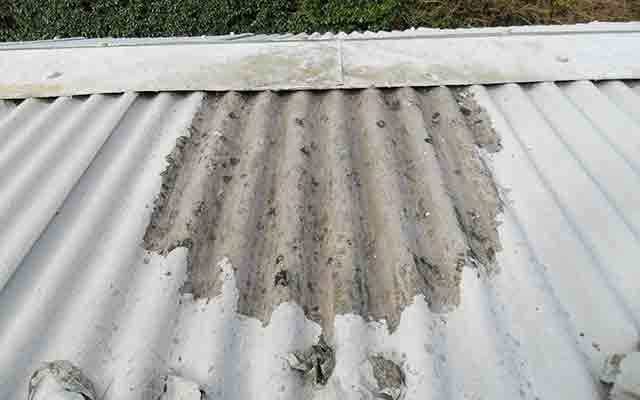
Without doubt, preparation is the most important part of any painting project
Skip, ignore or rush at this stage and it is highly likely that the old idiom ‘act in haste, repent at leisure’, may sum up the resulting outcome. One project, where insufficient preparation caused the paint to fail, is indicated in this photograph of a pitched garage roof.
The substrate was corrugated fibrous cement sheets, similar to asbestos. This type of material can become porous over a number of years and slowly starts to let the water through.
Prolonged damp periods can encourage the growth of mould, mildew, moss and algae, etc. If this organic contamination is not eradicated, it will grow underneath any new application of paint. This will cause the bond between the paint and the substrate to fail.
Cleaning
The proper cleaning procedure is essential. Firstly, any larger pieces of debris, such as moss balls, oil or bird droppings, should be brushed, scraped or spot cleaned from the surface. The ideal product for this would be something like the Rust-Oleum ND14 Cleaner and Degreaser. After a required drying period, the next stage would be to use a fungicidal wash. Promain supply this in concentrate form, as this provides a great value for money solution for our customers.
The solution is applied to the surface, either with a low pressure sprayer such as the Kingfisher Back Pack Sprayer, or by hand, and then allowed to dry.
Incidentally, this procedure would also apply to cleaning driveways, tennis courts, patios, balcony roofs, roof tiles, masonry walls etc., in preparation for specified maintenance projects.

Patch Repair
In the particular example that has been highlighted, in the above image, when painting a roof, ensuring a continuous membrane is the best approach. A ‘patch repair’ will not last, as this would allow water to creep underneath the paint.
So, when you are painting a roof, you have to ensure that the whole surface area is painted. For example, right under an overhanging lip – ensuring that no running or standing water has the opportunity to get underneath the coating being applied.
The image shows that the paint has de-laminated from the corrugated substrate. Dirt on the underside of the paint, which has been scooped to the sides, can clearly be seen. This has prevented the paint from adhering.
Is The Paint To Blame?
Visually, it appears that the paint has failed and the paint may somehow be defective or of an inferior quality. This is the incorrect conclusion, if you take a moment to consider what has actually happened here.
Even though this roof was scraped, brushed and appeared to be clean prior to painting, water has managed to get underneath from the top of the roof and has fed the algae and mould, resulting in a pronounced blister.
This is not beyond rectifying. However, the area needs to be re-cleaned, sterilised and allowed to dry before re-application. This will solve the issue. Ensuring that any such re-application extends underneath the overhang will reduce the chance of further disappointment.
Promain has a range of Cleaning Products, Degreasers and Cleaning Solutions and a wealth of knowledge, ready to assist our customers in achieving their desired project outcome.
Please contact the Promain Office to find out more or call 01462 421333.

